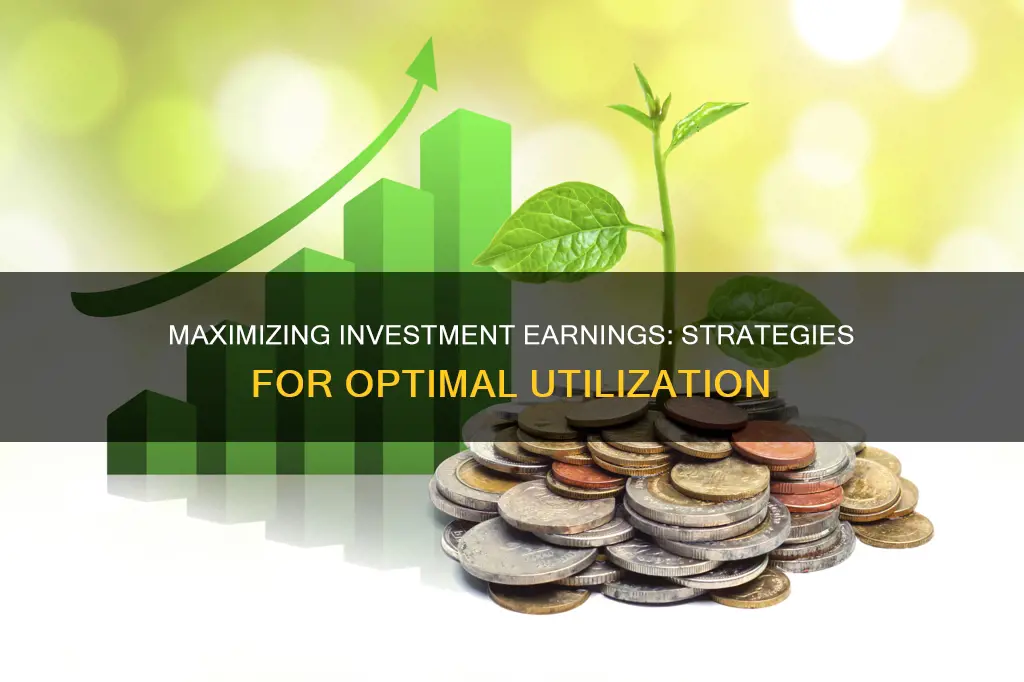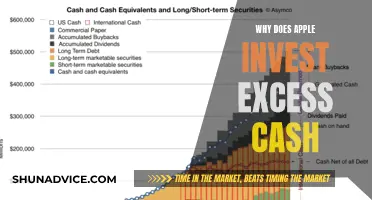
Knowing how to use your investment earnings is an important part of financial planning. Investment earnings, or investment income, is the gain in value you get from an investment. For example, if you buy stocks or shares, your investment income is the profit you make when you sell them, minus any fees or taxes. You can also earn investment income through interest on savings products, or by investing in assets such as property. The way you use your investment earnings will depend on your financial goals and risk tolerance. For example, you might choose to reinvest your earnings to maximise long-term growth, or you might prefer to use them to fund a large purchase or build up an emergency fund. It's important to remember that all investments carry some degree of risk, and there is no guarantee that you will make money. Seeking advice from a financial professional can help you understand how to use your investment earnings in a way that aligns with your goals and risk appetite.
What You'll Learn

Create an emergency fund
Creating an emergency fund is a crucial step in achieving financial security. This fund will act as a safety net in the event of unexpected expenses, such as car repairs, medical bills, or a loss of income. Here are some detailed guidelines on how to create an emergency fund using your investment earnings:
Set Clear Goals:
Start by setting a realistic savings goal. A common recommendation is to save enough to cover at least three to six months' worth of living expenses. However, this number may vary depending on your personal situation, such as the number of dependents you have or the stability of your income. If you're self-employed or your income fluctuates, you may want to aim for a larger emergency fund to provide extra security.
Start Small and Automate:
Don't be intimidated by the total amount you want to save. Even small contributions can add up over time. Set up an automatic transfer from your investment earnings to your emergency fund. This could be a monthly transfer of a manageable amount, such as $100, or a percentage of your earnings. By automating your savings, you make sure that the money goes directly into your emergency fund without you having to remember to transfer it manually.
Choose the Right Account:
Select an account that is easily accessible but not too convenient for everyday use. A basic savings account or a money market account linked to your checking account can be a good option. Look for an account that offers a small annual yield without any annual fees or minimum balance requirements. You want your money to be safe, liquid, and accessible within a day if needed, but not instantly.
Prioritize True Emergencies:
Only use your emergency fund for genuine emergencies, such as those mentioned earlier. Discipline yourself to leave the fund untouched for non-essential purchases or minor inconveniences. Remember, this fund is meant to provide financial security during unexpected and urgent situations.
Regularly Replenish:
If you do need to use your emergency fund, make sure to replenish it as soon as possible. Unplanned expenses can happen at any time, and sometimes they come in multiples. Continue to prioritize building your emergency fund until you reach your initial savings goal.
Creating an emergency fund is a crucial step in achieving financial security and peace of mind. By following these steps and utilizing your investment earnings, you can ensure that you have a safety net in place to protect yourself and your finances during unexpected events.
Investing Cash Flow: Exploring Other Items
You may want to see also

Pay off high-interest debt
If you have high-interest debt, such as credit card debt, it is generally recommended to pay this off before investing your earnings. Credit cards tend to charge high interest rates, often as much as 18% or more, and it is unlikely that any investment will give returns to match this interest rate. Therefore, it is wiser to eliminate all credit card debt before investing.
If you have unpaid balances on several credit cards, it is best to pay off the card with the highest interest rate first. While continuing to pay the minimum on your other cards, pay as much as you can towards the card with the highest rate until your balance is zero. The same advice applies to any other high-interest debt (about 8% or above) which does not offer any tax advantages.
Before paying off high-interest debt, it is recommended to have at least a small emergency fund saved. This will help to cover any costly, unexpected expenses, such as car repairs, medical bills, or job loss. It is also important to continue making minimum payments on all debts to avoid late fees and maintain your credit score.
If you have high-interest debt and are considering selling your investments to pay it off, it is generally advised to avoid doing so. However, there is an exception to this rule: if you have high-interest debt, such as outstanding credit card balances, it is recommended to take every possible measure to pay off this debt. It is important to note that the earnings rate of an investment is not guaranteed, whereas paying off debt has a known percentage value that can be realized.
Before selling your investments, it is recommended to first consider pausing contributions to your investments and redirecting this cash flow towards paying off your high-interest debt. You could also use a balance transfer credit card, which offers a 0% intro APR for a certain period, allowing your payments to chip away at your balance faster as they won't be accruing additional interest.
In summary, while investing is a great way to grow your money, it is generally recommended to prioritize paying off any high-interest debt first. This will help you save money on interest and maintain a healthy financial situation.
Understanding Cash Flows: Notes Receivable and Operating Cash
You may want to see also

Diversify your investments
Diversifying your investments is a crucial step in building a robust and resilient portfolio. Here are some detailed tips to help you diversify your investments effectively:
Understand the Importance of Diversification:
Diversification is not just about spreading your investments across different assets; it's about managing risk and improving returns. By allocating your capital across various investment types and industries, you can reduce the overall risk of your portfolio while also increasing potential returns.
Adopt a Disciplined Investment Approach:
Start by assessing your financial goals, risk tolerance, and investment horizon. Diversification is not a one-time task; it requires regular monitoring and rebalancing. Review your portfolio at least annually or whenever your financial circumstances change significantly. This helps maintain your desired risk level and strategic asset allocation.
Diversify Across Asset Classes:
Invest in a mix of stocks, bonds, cash, and other investment types. Each asset class has different risk and return characteristics, so diversifying across them can provide a balance to your portfolio. For example, stocks typically offer higher potential returns but come with higher volatility, while bonds are generally more stable but with lower returns.
Allocate Assets Based on Complementarity:
When selecting investments within an asset class, look for complementary options. Choose stocks from different industries that are not closely related so that a negative event affecting one industry doesn't impact all your holdings. For example, investing in both a package delivery company and a videoconferencing platform company can reduce risk, as a gas shortage would impact the former but may cause an increase in the latter.
Diversify Geographically:
Don't put all your eggs in one geographic basket. Consider investing in international markets to mitigate the risk of your home country's market performing poorly. Different countries and regions may have diverse economic cycles and factors influencing their markets, so spreading your investments globally can provide a hedge against country-specific risks.
Explore Alternative Investments:
In addition to traditional investments like stocks, bonds, and cash, consider alternative investments such as hedge funds, private equity, real estate, debt investing, commodities, collectibles, and structured products. These investments operate in the private market and are largely unregulated, offering a low correlation with traditional assets.
Remember, diversification is a long-term strategy, and its benefits may not be immediately apparent. It's important to periodically review and rebalance your portfolio to maintain your desired level of diversification and risk management.
Cash Value Life Insurance: Is It a Smart Investment?
You may want to see also

Dollar-cost averaging
For example, if you plan to invest $1,200 in Mutual Fund A in a year, you can either invest the entire amount at the beginning or end of the year, or you can invest $100 each month. If you spread out your purchases in $100 monthly portions over 12 months, you may end up with more shares than if you bought everything at once. If you buy $100 worth of Mutual Fund A a month for 12 months, your average price per share will be lower, and you will own more shares. When Mutual Fund A increases in value over the long term, you will benefit from owning more shares.
Free Cash Flow: Investment Costs and Their Inclusion
You may want to see also

Take advantage of employer contributions
Taking advantage of employer contributions is a great way to boost your wealth. Employer contributions are when your employer adds a certain amount to your retirement savings plan, which is based on how much you contribute. This is a benefit that can considerably boost your savings, and it is important to take advantage of it.
Employers can match a percentage of an employee's contribution, up to a certain limit, and this is typically a dollar-for-dollar match. For example, an employer might match 100% of contributions up to 5% of an employee's salary. So, if an employee contributes $50 from their $1000 weekly paycheck, the employer will contribute an additional $50, bringing the total contribution to $100.
It is important to note that employers are not required to offer these contributions, but they can choose to contribute as much or as little as they like, within federal limits. Some companies may even choose to make a contribution without requiring the employee to contribute, as a way to attract or retain talent.
The amount an employer chooses to contribute can vary, and it is important to understand the details of your employer's plan. Some companies offer more generous matches than others, and it is in your best interest to maximise this benefit. For instance, if your employer offers a 100% match on contributions up to 3% of your annual income, you should contribute that amount to take full advantage of the benefit.
By taking advantage of employer contributions, you are essentially getting free money added to your retirement savings. This is a great way to boost your savings and secure your financial future. It is a benefit that should not be overlooked, as it can make a significant difference in the long run.
Cash Value Annuities: Securities Investment Options Explored
You may want to see also
Frequently asked questions
The simplest way is to compare your ending value for a certain period to your beginning value. For example, if your portfolio is worth $58,000 on December 31 and your beginning value on January 1 was $50,000, you've made $8,000 in investment income.
Common financial investments include stocks, index funds, exchange-traded funds (ETFs), and mutual funds.
All investments carry risk, so it's important to carefully consider how your investment can perform based on different factors. Some common factors to keep in mind are risk and return, starting balance, contributions, rate of return, and years to accumulate.







